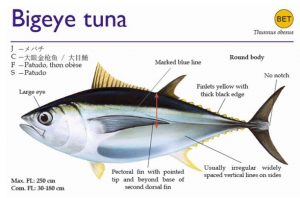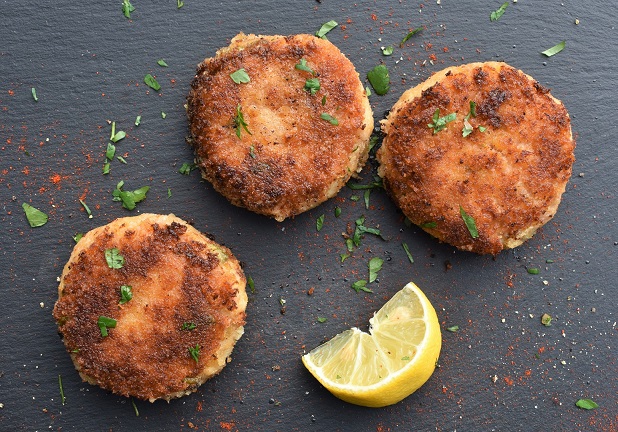Yellowfin Tuna Recipes
Yellowfin tuna, also known as Ahi, is a popular fish in the culinary world. Its firm texture and mild flavor make it versatile and easy to cook. Yellowfin tuna can be prepared in many ways, whether you grill it, sear it, or enjoy it raw. We’ll explore three key areas of grilling yellowfin, understanding its meat, and looking at its price. With these tips and recipes, you’re ready to bring the taste of the sea to your table.
Want to know more about Yellowfin Tuna? Check out our related articles.
-
Yellowfin Tuna Ahi Fishing Guide
Discover everything you need to know about Yellowfin Tuna or Ahi Tuna. Yellowfin Tuna is often called Ahi in Hawaii. It is one of the most popular and versatile fish you can find in kitchens worldwide. You may be searing it,…
-
Yellowfin Tuna vs Bluefin Tuna
I’ve never actually explored the difference between yellowfin and bluefin tuna. I guess yellowfin has yellow fins right?? I mean, they are both popular, and people love to talk about them like they are two completely different worlds of fish. So,…
-
How to Catch Yellowfin Tuna Trolling
Yellowfin Tuna, also known as Thunnus albacares, is a species of tuna that is deep blue on top, has a shallow yellow line all the way to the tail in the middle and their fins are yellowish color. Yellowfin is one…
Yellowfin Grilling
Grilling is one of the best ways to enjoy yellowfin tuna. The firm texture of the meat holds up well on the grill, and the flavor is enhanced by the smoky heat.
Choosing the Right Cut
For grilling, thick steaks are the best choice. Aim for pieces that are at least 1 inch (2.5 cm) thick. This thickness ensures the fish stays moist and doesn’t overcook too quickly.
Marinating Yellowfin Tuna
A simple marinade works wonders. Olive oil, lemon juice, garlic, and soy sauce are popular choices. Marinate the tuna for 30 minutes to an hour. This adds flavor without overpowering the natural taste of the fish.
Easy Tuna Marinade Recipe
- 1/4 cup (60 ml) olive oil
- 2 tablespoons (30 ml) lemon juice
- 2 cloves garlic, minced
- 1 tablespoon (15 ml) soy sauce
Grilling Yellowfin Tuna Techniques
Preheat the grill to high. Lightly oil the grill grates to prevent sticking. Grill the tuna steaks for about 2-3 minutes per side for a rare to medium-rare finish. If you prefer your tuna well-done, cook it for an additional 1-2 minutes per side. Remember, yellowfin tuna is best when it’s not overcooked. The center should remain pink and slightly translucent.
Serving Yellowfin Tuna
Grilled yellowfin pairs well with a variety of sides. A fresh salad, roasted vegetables, or a light pasta dish complement the fish nicely. Drizzle some extra marinade over the cooked tuna or serve with a lemon wedge for added brightness.
Yellowfin Meat
Yellowfin tuna is prized for its texture and flavor. The meat is firm and lean, with a subtle, slightly sweet taste.
Yellowfin tuna is often compared to beef due to its firm texture. It’s a meaty fish that holds up well to various cooking methods. The flavor is mild, making it a great option for those who find stronger-tasting fish overwhelming. When raw, the meat has a deep red color. When cooked, it turns a light beige or tan.
Yellowfin tuna is a healthy option. It’s high in protein, low in fat, and rich in omega-3 fatty acids. A 3-ounce (85 g) serving of yellowfin tuna provides around 25 grams of protein and only about 1 gram of fat. It’s also a good source of vitamins and minerals like B12, selenium, and niacin.
Cooking Yellowfin Tuna
Besides grilling, yellowfin tuna can be cooked in several ways
- Searing Quick and easy, searing tuna in a hot pan for 1-2 minutes per side keeps the inside tender and flavorful.
- Baking Bake tuna steaks at 400°F (200°C) for about 10-12 minutes, depending on thickness.
- Poaching Poaching in a broth or oil keeps the tuna moist and infuses it with flavor.
- Raw Preparations Yellowfin is often used in sushi, sashimi, and poke bowls. The freshness of the fish is key in these dishes.
Yellowfin Tuna Price
As of 2024, the average price for fresh yellowfin tuna in the U.S. ranges from $10 to $30 per pound ($22 to $66 per kilogram). Prices can be higher for premium cuts or sushi-grade tuna. Frozen tuna tends to be cheaper, often around $8 to $15 per pound ($18 to $33 per kilogram).
The price of yellowfin tuna varies depending on several factors such as
- Seasonality Tuna prices can fluctuate based on the time of year. The peak season for yellowfin is summer to early fall, which might bring prices down slightly due to higher availability.
- Location Where the tuna is sourced can affect the price. Tuna caught locally might be cheaper than imported varieties.
- Quality Higher-grade tuna, especially sushi-grade, will command a higher price. Fresh, high-quality yellowfin is more expensive than frozen or lower-grade options.
Buying Yellowfin Tuna
- Freshness Look for tuna with a bright, shiny appearance and a fresh, ocean-like smell. Avoid any fish with a strong, fishy odor or dull color.
- Sushi-Grade If you’re planning to eat the tuna raw, make sure it’s labeled as sushi-grade. This indicates that the fish has been handled and frozen to specific standards to ensure safety.
- Portion Size When buying yellowfin tuna, estimate about 6-8 ounces (170-225 grams) per person for a main course serving.
 Buy Baking Pans
Buy Baking Pans
Yellowfin Tuna Cooking FAQ
Is Yellowfin Tuna Safe to Eat Raw?
Yes, yellowfin tuna is safe to eat raw if it’s sushi-grade. Always buy from a reputable source and make sure the fish is fresh.
How Should I Store Yellowfin Tuna?
Store fresh yellowfin tuna in the coldest part of your refrigerator and use it within 1-2 days. For longer storage, wrap it tightly in plastic wrap and freeze it.
Difference Between Yellowfin and Bluefin Tuna?
Yellowfin tuna is more widely available and less expensive than bluefin tuna. Bluefin has a richer flavor and a higher fat content, making it more sought after for sushi and sashimi.
Can I Use Yellowfin Tuna for Ceviche?
Yes, yellowfin tuna is a great choice for ceviche. Its firm texture holds up well in the acidic marinade, and the mild flavor pairs well with citrus and herbs.
What Wines Pair Well with Yellowfin Tuna?
A light, crisp white wine like Sauvignon Blanc or Pinot Grigio pairs well with grilled yellowfin tuna. For seared or raw preparations, a light red like Pinot Noir can be a good match.
How Long Can I Keep Yellowfin Tuna in the Freezer?
Yellowfin tuna can be kept in the freezer for up to three months. Make sure to wrap it tightly to prevent freezer burn.
Good Seasonings for Yellowfin Tuna?
Simple seasonings like salt, pepper, and lemon work well with yellowfin tuna. For a bolder flavor, try a rub with garlic, paprika, and cayenne pepper. Soy sauce, ginger, and sesame oil are great for an Asian-inspired twist.




 Rigged Trolling Flexi Spreader Bar Topwater
Rigged Trolling Flexi Spreader Bar Topwater 36″ Skipjack Hybrid UV 8″ Blue & Pink Mackerel Baits
36″ Skipjack Hybrid UV 8″ Blue & Pink Mackerel Baits Mini Spreader Bar
Mini Spreader Bar Big Eye Rocket 9″
Big Eye Rocket 9″ Penn Tuna Fishing Rod & Reel Combo
Penn Tuna Fishing Rod & Reel Combo View Best Tuna Fishing Lures
View Best Tuna Fishing Lures





 Buy Panko Breadcrumbs
Buy Panko Breadcrumbs